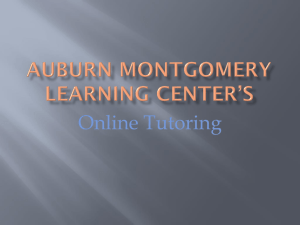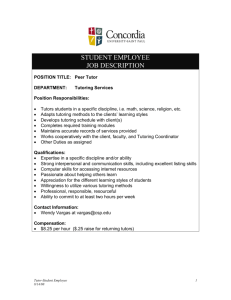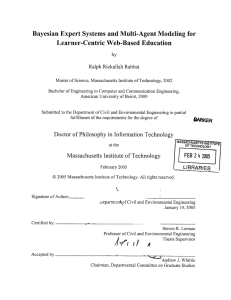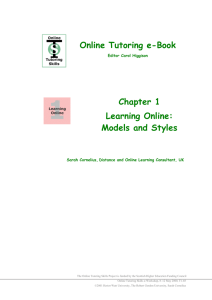Tutoring Strategies
advertisement
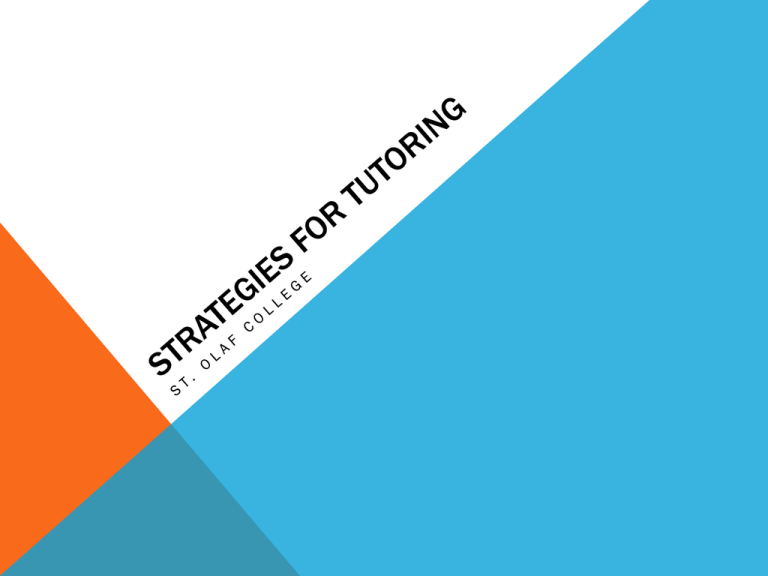
ESTABLISHING A SUCCESSFUL ENVIRONMENT Northfield Reads and Counts Tutor Program • Establish rapport with students • Develop a healthy environment both personally and academically • Helping give students the assistance and tools for success PERSONAL RELATIONSHIPS • • Spend a little time each session “catching up” Create supportive and non-judgmental environment • Positive, Calm, Assured, Encouraging • Positive Feedback • Never respond by simply saying “good job” • • • Respond to right answers with another question • You did excellent sounding out that word, what do you think that word means?” Great Tutoring ≠ Feeding Answers Be proactive • Motivate. Encourage. Inspire. ACADEMIC RELATIONSHIPS • • • Discuss BEING PREPARED for class (bringing notebook, pencil, textbook) Discuss practicing good listening skills in class • Good study skills Review ideas and concepts from previous sessions • Help your students learn how to learn. • Provide tools • Assist in finding resources – media center, making flash cards, etc. • Use student experience to assist • Make material relatable! • Skittles/apples for probability, chocolate bar for fractions • Great Tutoring ≠ Feeding Answers • Your students “hold the pencil” – Don’t do their work, always try to end on successful note HOW STUDENTS LEARN Students have learning styles that are as different as DNA! Majority of Children Learn in 3 Different Styles: 1. Visual Learning - Have to see to understand 2. Aural Learning - Learn by verbal cues and instruction 3. Kinesthetic Learning - Hands-on learners TUTORING MATH • • Break down math concepts into smaller parts Walk through problems step-by-step together • Write and complete additional sample problems together • Explain concepts within a context of interest • Apples/Skittles to discuss probability • Cater to the 3 Styles of Learning • Visual – charts, pictures, figures • Verbal – Talking through formulas and word problems • Kinesthetic – using coins for percentages or decimals • Provide more than one way of solving problems/equations TUTORING IN READING • Give your Students Context • Before you Read • Identify Key Elements of the Story • Title • Author • Characters • Setting • Make Predictions • Look at Cover Art and hypothesize plot WORD RECOGNITION • Break down words into smaller parts (Word Chunking) • Prefix and Suffix • Consonant Sounds • Use Picture Clues • Word-to-picture associations • Apply Common Phonic Rules • Words with Silent –e • Cake, Bake, Dive, Home • Apply Stylistic Learning • Using Finger to cover up parts of word (Visual) • Use finger to spell and sound out words • Read it Again! • Use Context Clues READING COMPREHENSION • Make Predictions Before Reading • Cover Art, Chapters, Pictures • Ask Questions • Students make Pre-Reading questions based on Predictions • Have students write down questions as they read • Make a Book Map • Characters • Setting • Events READING COMPREHENSION • Be Cognitive Coaches • As Open-Ended Questions with multiple answers • Make students form opinions • Make Story Relatable • Do the characters learn something you’ve learned in school? • Are Characters Similar to people in “Real Life?” TUTOR STRATEGIES Questions?


